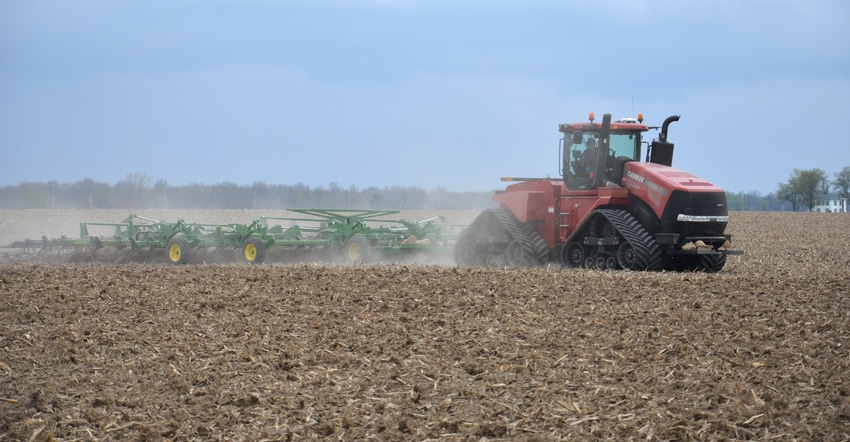
You know that a lot of things can affect crop yield, especially corn, and weather is the single biggest factor of them all.
But with the growing season right around the corner, it’s time to start thinking of ways to get the field set up for a maximum payoff come fall.
At this year’s virtual Commodity Classic, Alison Bryan, research agronomist with Case IH, and Chris Lursen, a farmer and tillage marketing manager with Case IH, provided insights into field preparation techniques and some new technologies that can help growers achieve better yields.
With the middle of March now upon us, the countdown to spring planting is on. The right soil temperature and moisture are critical to get seeds going once they’re planted, so timing is important.
“Temperature is a prominent cue that will dictate when a seed will start germinating, and moisture is needed to wake up the seed," Bryan said. "So you want to make sure you give it the best environment possible for that. The proper seed-to-soil contact provides the easiest access for soil moisture."
Properly working the ground lays that foundation. One way that Bryan measures this is getting “down and dirty” and cutting some plants on the soil surface, from the mesocotyl down to the top of the seed to measure soil depths.
Bryan said this provides good insights into the various microclimates that can develop in a field. If a seed is planted deeper, it will likely hit more moisture but less heat. If it’s planted closer to the surface and it’s dry, it will hit less moisture but more heat.
These variations can lead to uneven stands and likely lower yields.
Bryan talked about research she and others have performed to look at the effects uneven growth has on overall yield. On a research farm in Illinois, they marked plants at optimum growth stage, one growth stage behind and two growth stages behind.
Plants that were on time and were uniform scored the highest yields, she said. But plants that were a growth stage behind saw 50% yield loss, and plants that were two growth stages behind saw 78% yield loss.
This was a sample of a field in Illinois, and not every field will be picture perfect. But there’s an important take-home message.
“If this is happening enough in your field, this is going to be an issue because those neighbors that did come up on time were not able to compensate enough for the ones that didn’t,” she said.
Start smooth
As a farmer, Lursen looks for an efficient seedbed that’s flat and smooth, one that will enable his planter to go through and place seed nice and even.
This can be easy to see on the surface, but, “The seedbed is more than just the surface,” he said.
A lot of things are going on underneath, and that can vary greatly across an entire field. But what’s the correlation to yield?
Bryan put this to the test by running a field cultivator — a TigerMate with seedbed-sensing technology — with sensors installed on the shanks to measure quality, speed and other factors on a 50-acre field in central Illinois. The test was performed in early May on a field of soybean stubble that had variable soils and sloping. No on-the-fly adjustments were made.
They then went in with a 16-row planter and planted a crop, taking a look at planter unit ride after the cultivator came through. They layered data from the cultivator and planter and followed the crop all the way to yield to find correlations.
“It actually did alter the planter performance,” Bryan said. But how did it affect yields? Bryan said that in areas where the cultivator detected rougher soil conditions, grain yields were lower. In areas where soil conditions were better, grain yields increased by 6 bushels per acre in some areas, and by 12 bushels per acre in the best conditions.
“This is something that we saw throughout, and it reflected in grain yield,” she said. “It’s definitely a result of what we were detecting with those sensors. That could be related to the soil itself, but it’s a good tool in the toolbox.”
Tillage scripts
A new tool in the toolbox is prescriptive tillage technology.
“It’s really about tailoring the needs of that field to a soil management tool,” Lursen said. “And really, this takes the guesswork out of what the operator is doing in the field as the tool will adjust itself.”
For a ripper or vertical tool, this can involve creating a prescription for tillage, or even no-till, based on soil type, topography, residue or compaction. For example, if a lot of residue is left out in a field at harvest, you can use a yield map to create a script for more aggressive tillage in heavy residue.
“Before you go into those fields, you’re prepared for those differences in soils,” Bryan said.
For example, using a True Tandem Vertical Tillage 335VT with Case IH’s AFS Soil Command, Bryan was able to create a tillage script based on topography and soil type. Low-lying areas of the field with little to no residue got minimum or no tillage, while areas with higher residue got more aggressive tillage, all in the same field. The tillage depth varied from 0 to 2.5 inches deep.
While the implement was equipped with the Soil Command system, a separate AFS software was used to create the prescription. These are the two critical pieces you need to be able to do this kind of work, Bryan said.
And you also need the knowledge and guidance to create the prescription, either working with an agronomist or, if you feel comfortable, doing it yourself.
About the Author(s)
You May Also Like






